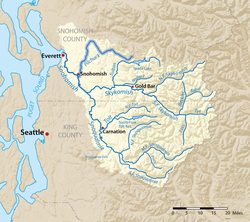Pilchuck River
| Pilchuck River | |
|---|---|
 Map of the Pilchuck River highlighted in the Snohomish River watershed | |
| Location | |
| Country | United States |
| State | Washington |
| Region | Snohomish County |
| Cities | Snohomish, Granite Falls |
| Physical characteristics | |
| Source | Cascade Range |
| - coordinates | 47°59′19″N 121°40′43″W / 47.98861°N 121.67861°W / 47.98861; -121.67861[2] |
| - elevation | 2,125 ft (648 m)[1] |
| Mouth | Snohomish River |
- coordinates | 47°54′13″N 122°5′27″W / 47.90361°N 122.09083°W / 47.90361; -122.09083Coordinates: 47°54′13″N 122°5′27″W / 47.90361°N 122.09083°W / 47.90361; -122.09083[2] |
- elevation | 8 ft (2.4 m)[1] |
| Length | 40 mi (64 km)[1] |
| Basin size | 127 sq mi (330 km2)[3] |
| Discharge | |
| - average | 467 cu ft/s (13.2 m3/s) |
| - minimum | 36 cu ft/s (1.0 m3/s) |
| - maximum | 5,050 cu ft/s (143 m3/s) |
The Pilchuck River is a river in the U.S. state of Washington. The name is derived from Chinook Jargon pilpil ("blood", "red") and chuck ("water"), or "red water".[4]
Course
The Pilchuck River originates in the Cascade Range. It flows generally west and then south, past Granite Falls, to join the Snohomish River near Snohomish. The Snohomish empties into Possession Sound, part of Puget Sound.[3]
See also
- List of rivers of Washington
References
^ abc Calculated via Google Earth
^ ab U.S. Geological Survey Geographic Names Information System: Pilchuck River
^ ab Washington Water Year 2005, USGS Water Resources Data
^ Bright, William (2004). Native American placenames of the United States. University of Oklahoma Press. p. 382. ISBN 978-0-8061-3598-4. Retrieved 6 April 2011..mw-parser-output cite.citation{font-style:inherit}.mw-parser-output q{quotes:"""""""'""'"}.mw-parser-output code.cs1-code{color:inherit;background:inherit;border:inherit;padding:inherit}.mw-parser-output .cs1-lock-free a{background:url("//upload.wikimedia.org/wikipedia/commons/thumb/6/65/Lock-green.svg/9px-Lock-green.svg.png")no-repeat;background-position:right .1em center}.mw-parser-output .cs1-lock-limited a,.mw-parser-output .cs1-lock-registration a{background:url("//upload.wikimedia.org/wikipedia/commons/thumb/d/d6/Lock-gray-alt-2.svg/9px-Lock-gray-alt-2.svg.png")no-repeat;background-position:right .1em center}.mw-parser-output .cs1-lock-subscription a{background:url("//upload.wikimedia.org/wikipedia/commons/thumb/a/aa/Lock-red-alt-2.svg/9px-Lock-red-alt-2.svg.png")no-repeat;background-position:right .1em center}.mw-parser-output .cs1-subscription,.mw-parser-output .cs1-registration{color:#555}.mw-parser-output .cs1-subscription span,.mw-parser-output .cs1-registration span{border-bottom:1px dotted;cursor:help}.mw-parser-output .cs1-hidden-error{display:none;font-size:100%}.mw-parser-output .cs1-visible-error{font-size:100%}.mw-parser-output .cs1-subscription,.mw-parser-output .cs1-registration,.mw-parser-output .cs1-format{font-size:95%}.mw-parser-output .cs1-kern-left,.mw-parser-output .cs1-kern-wl-left{padding-left:0.2em}.mw-parser-output .cs1-kern-right,.mw-parser-output .cs1-kern-wl-right{padding-right:0.2em}
This Snohomish County, Washington state location article is a stub. You can help Wikipedia by expanding it. |
This article related to a river in the state of Washington is a stub. You can help Wikipedia by expanding it. |